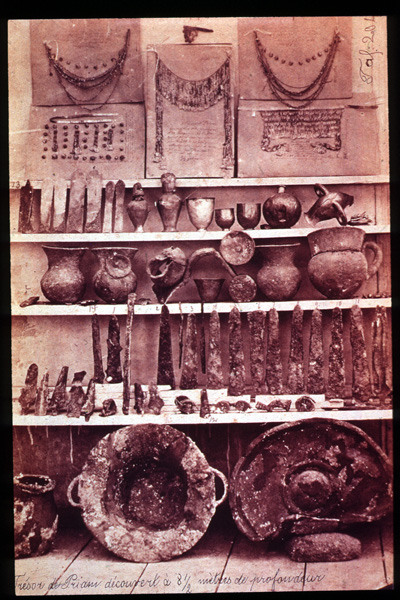
The Diadem from “Priam’s Treasure” at the Pushkin Museum is part of what became called the “Treasure of Priam” discovered in the ancient site of Troy, which is in modern-day Turkey.
Ancient Troy was the setting of the Trojan War described in the Greek Epic Cycle, in particular in the Iliad, one of the epic poems by Homer.
“Priam’s Treasure” is a cache of gold and other artifacts discovered by Heinrich Schliemann in 1873. The artifacts are spread across multiple museums, including:
- Pushkin Museum, Moscow, Russia
- Neues Museum, Berlin, Germany
- Istanbul Archaeology Museum, Istanbul, Turkey

“Priam’s Treasure” discovered by Heinrich Schliemann. The collection was divided after 1880. This photo most was taken before the collection was broken up across multiple museums
Schliemann claimed the site to be that of ancient Troy and assigned the artifacts to the King Priam of Troy, from Homeric.
This assumption was the result of Schliemann’s ambition to find sites and objects mentioned in Homer’s epics, which took place in southwestern Turkey.
At the time, archaeology was in its infancy, and the stratigraphy at Troy had not been scientifically undertaken.
Subsequently, to Schliemann’s discoveries, the layer in which “Priam’s Treasure” was alleged to have been found has been assigned to an earlier period of Troy, which pre-dated Priam the King of Troy, of Trojan War fame, by hundreds of years.
Many experts believe that the treasures are a thousand years older than Homer’s King Priam of Troy, who died about 1200 B.C.
The “big” Diadem from Priam’s Treasure at the Pushkin Museum
The story of Heinrich Schliemann’s discoveries is now famous and controversial.
During 1871-73 and then 1878–79, Schliemann excavated a hill called Hissarlik in the Ottoman Empire, near the town of Chanak (Çanakkale) in north-western Anatolia, Turkey.
At this site, he discovered the ruins of a series of ancient cities, dating from the Bronze Age to the Roman period.
Heinrich Schliemann declared one of these cities to be Troy, and this declaration was widely accepted at that time and publicized in the global press. Schliemann reported the discovery as follows:
“In excavating this wall further and directly by the side of the palace of King Priam,
I came upon a large copper article of the most remarkable form,
which attracted my attention all the more as I thought I saw gold behind it. …
In order to withdraw the treasure from the greed of my workmen, and to save it for archaeology, …
I immediately had lunch break called. …
While the men were eating and resting,
I cut out the Treasure with a large knife….
It would, however, have been impossible for me to have removed the Treasure without the help of my dear wife,
who stood by me ready to pack the things which I cut out in her shawl and to carry them away.”
Later archaeologists condemned Schliemann’s excavations as having destroyed the main layers of the real Troy.
One archaeologist claimed that Schliemann’s excavations were carried out with such non-archaeological methods that “he did to Troy what the Greeks couldn’t do in their time.” Other scholars agree that the damage caused to the site is irreparable.

Heinrich Schliemann (1822 – 1890)
Other Heinrich Schliemann’s historic discoveries include:
- Mask of Agamemnon
- Priam’s Treasure Necklace
- Priam’s Treasure
Priam’s Treasure
- Title: Priam’s Treasure
- Date: 2200 BCE
- Material: Gold and other metals
- Discovered: 1873: Site of Ancient Troy in modern Turkey
- Museums: Pushkin Museum
Priam’s Trojan Treasure
A Virtual Tour of the Pushkin Museum
- “Bucentaur’s return to the pier by the Palazzo Ducale” by Canaletto
- Priam’s Treasure
- “Seagulls, the River Thames and the Houses of Parliament” by Claude Monet
- “Not to work” by Paul Gauguin
- “Horse Attacked by a Jaguar” by Henri Rousseau
- “Seascape at Saintes-Maries” by Vincent van Gogh
- “Portrait of Doctor Félix Rey” by Vincent van Gogh
- “The Red Vineyard” by Vincent van Gogh
Pushkin Museum Priam’s Treasure
Museums in Russia
-
Museums in Moscow
- Pushkin Museum
- Tretyakov Gallery
Treasure of Priam
-
Museums in Saint Petersburg
- Hermitage Museum
- State Russian Museum
The Truth about TROY
~~~
“No man or woman born, coward or brave can shun their destiny.”
– Homer, The Iliad
~~~
Photo Credits: 1)See page for author [Public domain], via Wikimedia Commons 2) Public Domain, Link3) I, Sailko [GFDL (http://www.gnu.org/copyleft/fdl.html) or CC BY-SA 3.0 (http://creativecommons.org/licenses/by-sa/3.0)], via Wikimedia Commons 4) See page for author [Public domain], via Wikimedia Commons
Popular this Week








 Sponsor your Favorite Page
Sponsor your Favorite Page SEARCH Search for: Search Follow UsJoin – The JOM Membership Program
Sponsor a Masterpiece with YOUR NAME CHOICE for $5
Share this:
- Tweet

